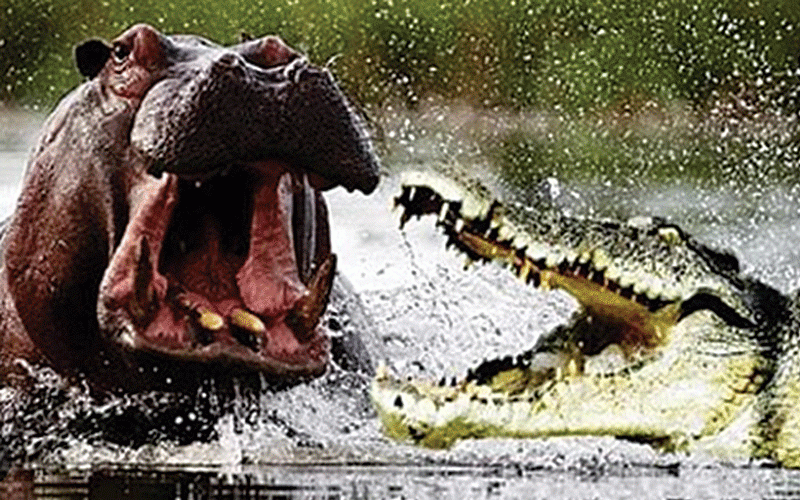
It was once a gently flowing river, where fishermen cast their nets, seabirds came to feed and its natural beauty left visitors spellbound.
Villagers collected water for their homes and farms thrived on its irrigation channels.
But today, Manyame is a river in crisis, choked by the domestic waste of millions of people and thick with the cast-off from water hyacinth feeding off raw sewerage poured in by local authorities along the meandering river and siltation from hundreds of gold panners along the way.
So dense is the carpet of refuse and water hyacinth that the tiny wooden fishing craft which float through it are the only clue to the presence of water.
Their occupants can no longer try to fish as they used to do. Apparently, it would be more profitable for villagers along Manyame River and surrounding dams to forage for rubbish they can salvage and trade — plastic bottles, broken chair legs, rubber gloves — risking disease for few dollars a week if they are lucky.
The troubled river is under Manyame catchment council, which covers Harare, Chitungwiza, Norton, Mhangura and Chinhoyi among others.
Most of the dams under the catchment area are Chivero, which is Harare’s major water supply, Mazvikadei, Eastwolds, Susuje and Ghost Acre.
Soon we may have to advise residents and visitors alike not to drink tap water because the river now displays after-effects of the shocking abuse that mankind has subjected it to.
- Chamisa under fire over US$120K donation
- Mavhunga puts DeMbare into Chibuku quarterfinals
- Pension funds bet on Cabora Bassa oilfields
- Councils defy govt fire tender directive
Keep Reading
Manyame catchment has reportedly tried to engage the Environmental Management Agency (EMA) so that they may take polluters to task, but EMA is reportedly not forthcoming.
Recently, EMA officials attended only two catchment council meetings despite being formally invited to all meetings. This again showed little or no regard to the pollution affecting the country’s capital, Harare.
The water hyacinth weed, which used to be confined to Chivero and Darwendale dams, is now spreading to downstream parts of Manyame River as far off as Chinhoyi and Raffingora, meaning the river is becoming more polluted as urban populations are increasing.
Water Resources minister Samuel Sipepa Nkomo, Local Government’s Ignatius Chombo and Natural Resources minister Francis Nhema should together visit the most polluted areas along Manyame River like Chitungwiza, Crowborough and Firle Sewerage Works in Harare, Cold Stream in Chinhoyi and Angwa River in Mhangura where there is rampant alluvial gold panning.
Chairman of Manyame sub-catchment area Roy Bvekerwa said the raw sewerage was affecting agriculture production on farmland along Manyame river.
“Disposing raw sewerage into rivers is the easiest and least costly way of dealing with sewage problems by local authorities.
However it’s costly to agriculture and creates unnecessary health problems.
When river systems are clogged, more money would now be needed to rectify the problem.
“Gardens especially in Raffingora and other areas down the river have been affected, water hyacinth is spreading, and so, millions of dollars would now be required simply to deal with these issues. Political will is needed, to decisively deal with environmental pollution in Zimbabwe,” Bvekerwa said.
On top of the agricultural chemicals used by resettled farmers along the river, go all the other kinds of human detritus from the factories and the people who work there.
There is also massive water pollution as a result of car washing in rivers such as in Ruwa, Karoi and Avondale.
Some residents have also developed a habit of dumping in water due to poor waste management practices by most local authorities.
Manyame catchment council says it has also tried in vain to sound its concern at the cutting down of trees for firewood by residents and farmers in the catchment for domestic and tobacco curing purposes but the policing agencies seem uninterested in doing their work.
It is really pathetic to note how the forests are fast diminishing.
There is no more such luxury as a rubbish collection service in these local authorities anymore.
Nor are there any modern garbage dumping facilities.
It looks like everything is going into the river.The filthy water is sucked into agriculture farmland, while families risk their health by collecting it for drinking, cooking and washing.
Decades back, Harare was a place of beauty, and the river still served its people well.
But today, plastic rubbish has clogged up the waterways and their demise began with lack of political will from the late 1980s.
And the doomsday effect will spread.
A University of Zimbabwe scientist Chris Magadza recently said treated water supplied to Harare residents does not meet minimum World Health Organisation standards.
He predicted that as the river chokes, its volume will decrease.
“Clinical studies carried out on Harare’s water supplies and results obtained revealed that Harare’s water bodies carry a significant amount of pollutants which pause a potential health risk.
The catchment water supply for Chivero is swiftly decreasing, making Harare increasingly reliant on recycled sewage. The water table for Harare has sunk from 15 to 30 metres within the last decade.
It is sad to note that a number of people are getting residential or commercial stands on wetlands thus disturbing the system.”
Magadza said lakes Chivero and Manyame were heavily polluted, hence urgent need for education on the importance of wetlands in the purification of water.
And perhaps the river will begin to breathe again.











